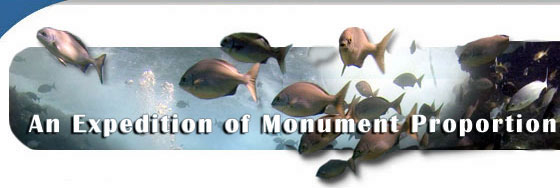|
Mission Log: July 1, 2006
Mapping Continues at Kure Atoll
Kelly Gleason
Maritime Archaeologist
 |
| Maritime archaeologist Tane Casserley documents the 19th century whaling shipwreck site at Kure Atoll. (Photo: Brenda Altmeier) |
Today marked the team’s third day of successful operations at Kure Atoll. The weather has become more and more conducive to diving on the dynamic reef where the Saginaw is located. The favorable conditions have allowed the entire team to get on the site and explore the dramatic spur and groove topography for the expanses of the scatter of this shipwreck site.
The USS Saginaw wrecked on a moonless night, and was quickly broken apart by the reef. It is incredible to see the way that the parts of the ship have worked their way into the grooves and crevices of the atoll.
Each reconnaissance dive brings more of this shipwreck to light. Today, three pairs of two divers each jumped in on the site. As the divers explored the site below, the coxswain of HI-1 “liveboats” (does not set an anchor) follows a float that the divers send up to the surface.
 |
| A maritime archaeologist dives through the spur and groove topography near the USS Saginaw shipwreck site. (Photo: Brenda Altmeier) |
Pipes, iron ballast, cannon, anchors and various types of ship steam machinery are abundant in and around the area where the ship was lost in 1870, and the team is documenting and interpreting the artifacts that they discover during the daily dives at the site.
Following the morning’s dive at the USS Saginaw site, the team headed six miles inside of the lagoon to the wreck site they believe to be the American whaler Parker. The team is getting close to completing the survey measurements, which will create the detailed site map. The photomosaic of the shipwreck site has started as well. These are both important products for interpretation of this site.
 |
| A maritime archaeologist uses a metal detector at the whaling shipwreck site at Kure Atoll. (Photo: Brenda Altmeier) |
The team finished the day of operations by locating the trail of debris which leads from a small opening in the reef crest into the lagoon and the present wreck site. This trail is littered with the bricks and broken pieces of the tryworks that indicate that this ship is indeed a whaler.
To add another dimension of site analysis, the team deployed the Seabird 19 CTD probe at the Parker site, to be recovered in 24 hours. This instrument will help the maritime archaeologists gather baseline data of the environment surrounding the shipwreck. Understanding environmental factors impacting the wreck will help the team understand the deterioration rate and other site formation processes. This team is working to fully understand the complex environment these shipwreck sites inhabit, adding an oceanographic and biological element to underwater archaeological site survey.
|



